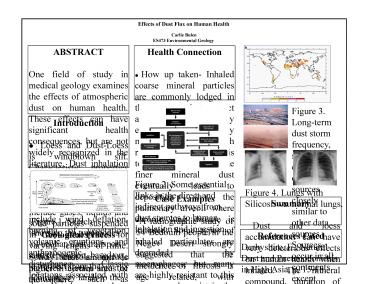ABSTRACT - PowerPoint PPT Presentation
Title:
ABSTRACT
Description:
... silicosis, fibrosis, asbestosis. Figure 3. Long-term dust storm frequency, showing a distribution of major sources closely similar to other data sources. – PowerPoint PPT presentation
Number of Views:65
Avg rating:3.0/5.0
Title: ABSTRACT
1
Effects of Dust Flux on Human Health
Carlie Bulen ES473 Environmental Geology
ABSTRACT One field of study in medical geology
examines the effects of atmospheric dust on human
health. These effects can have significant health
consequences, but are not widely recognized in
the literature. Dust inhalation and lung
accumulation is known to cause long term chronic
health conditions. Sources in the atmosphere
include wind deflation, burning of vegetation,
volcanic eruptions, and anthropogenic
disturbance. Classic locations associated with
dust-related lung complications include the great
dry lands of the northern hemisphere, the U.S.
Great Basin, and southern hemisphere arid regions
of Australia, South America and southern Africa.
These locations are notoriously associated with
high rates of silicosis and asbestosis, and
attendant lung disease. Factors that influence
the severity of these conditions include duration
of exposure, the size of particles inhaled, and
the toxicity of minerals comprising the
particles. One detrimental element found in dust
particles that is linked to a significant number
of these conditions is silica. Although
dust-related lung disease is a significant
problem in underdeveloped countries and desert
regions, few public health actions are being
implemented to mitigate harmful effects of dust
inhalation. This paper presents an overview of
the geological influences on global dust flux and
case examples of chronic health effects
associated with excessive inhalation.
- Health Connection
- How up taken- Inhaled coarse mineral particles
are commonly lodged in the upper respiratory
tract and are rejected by expectoration, but they
may constitute a health risk if the mineralogy is
toxic. Inhalation of the finer mineral dust
eventually leads to deposition in the pulmonary
alveoli where chronic lung disease is initiated.
Some types of inhaled particulates are degraded
by macrophages, but many are highly resistant to
this process and persist in the lungs. The
fraction of dust that penetrates more deeply into
the finer lung passages may cause silicosis,
asbestosis, and other lung conditions. - What effects on the body- factors include
size, shape, chemical and mineral composition of
dust particles, length of exposure, and certain
lung functions. - Lung Conditions- Pneumoconiosis, silicosis,
fibrosis, asbestosis.
Figure 3. Long-term dust storm frequency, showing
a distribution of major sources closely similar
to other data sources. Sources occur in all
continents except Europe and Antarctica. Figure
4. Before and during a Mongolian dust pall over
Beijing, April 2003.
- Introduction
- Loess and Dust-Loess is windblown silt.
Characteristic properties of loess include high
porosity and collapsibility on wetting. Dust
aerosols include gases, liquids and solid
particles suspended in the atmosphere for varying
lengths of time. Solid aerosols include particles
injected into the atmosphere such as mineral dust
and sea salt, and those that form within the
atmosphere, such as sulfates. Other contributors
to dust hazards are smoke plumes from natural and
man-made fires, and biomass burning, producing
black carbon. - Mineral components- Loess mineralogy consists
of angular, blade-shaped, quartz grains, with
minor feldspars, micas and carbonates. - Where found- High Asia, China, U.S. Great
Basin, North Africa, Middle East, Australia,
South Africa, and South America.
Figure 2. Some essential links in the direct and
indirect pathways from dust sources to human
inhalation and ingestion.
Figure 4. Lungs with Silicosis vs. normal lungs.
- Case Examples
- A radiographic study of 54 Bedouin people in the
Negev Desert strongly suggested that the
incidence of fibrosis is age related, with
progression more notable in women (13 out of 22)
than in men (only 4 out of 32), perhaps related
to greater exposure in and around the family
tents. - In Ladakh dust storms are frequent, mineral dust
found on the wooden beam rooftop of Ladakhi
houses is all finer than 15 µm, more than 25 by
weight being finer than 1 µm. The silica content
gt60. Study of necropsy lung tissue samples from
villagers revealed heavy dust deposition with
abundant hard 1-3mm nodules and a lymph node
largely replaced by hyaline collegenous nodules,
a classis feature of silicosis. - Mineral dust finer than 3 µm found in lung tissue
form one Chinese postmortem subject made up about
75 by weight of the total dust burden in the
lungs.
Summary Dust and loess accumulation can
have very deleterious effects on human health
when inhaled. The mineral compound, duration of
exposure, and particle size and shape can
influence these effects and cause such lung
complications as silicosis, asbestosis,
pneumoconiosis, and fibrosis. The Worlds dry
lands are a major source of dust and are
associated with many cases of these and other
lung complications and diseases.
Figure 1. Sketch showing the two modes of aeolian
dust transport and deposition, based on a
transect from the Chinese dry lands to the Loess
Plateau and the North Pacific Ocean.
- Geological Process
- Why dust amount is higher in certain areas of
the world - 1-High Asia- one of the worlds most efficient
producers of loess due to the combination of the
highest known uplift rates, rapid river incision,
unstable slopes, glaciations and widespread rock
breakup by crystal growth during freezing, and by
hydration of salts. - 2-North Africa and China- dried out former lake
beds, deserts. In parts of North China loess
formation exceeds 300m in thickness.
References Cited Derbyshire, E., Natural Dust and
Pneumoconiosis in High Asia, p.
15-18. Derbyshire, E., 2005, Natural Aerosolic
and Mineral Dusts and Human Health Elsevier
Inc., p. 459-480. Derbyshire, E., 2007, Natural
Minerogenic Dust and Human Health Royal Swedish
Academy of Sciences, p. 73-77.































